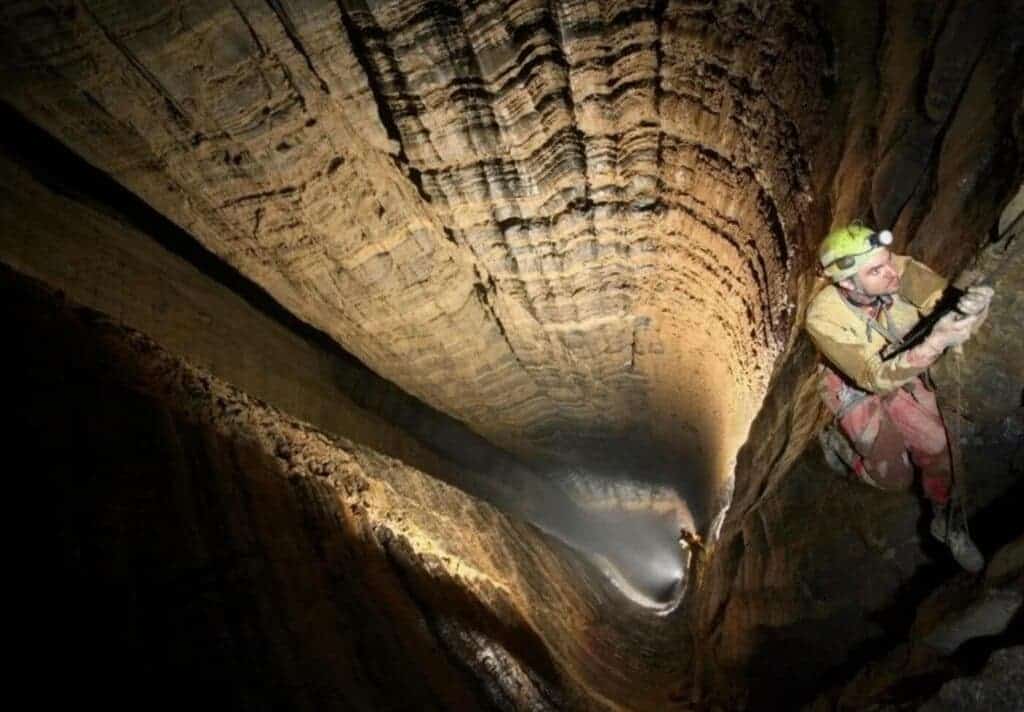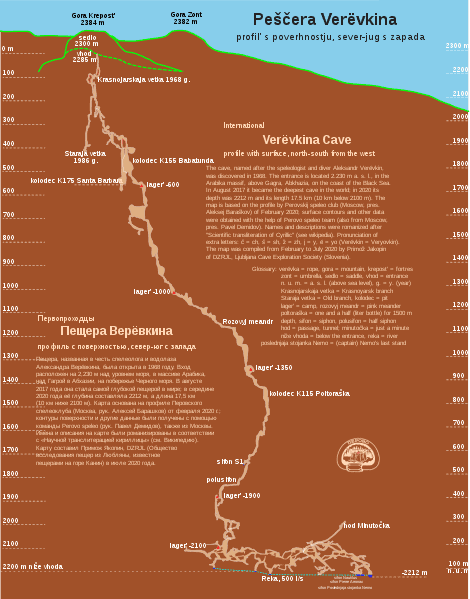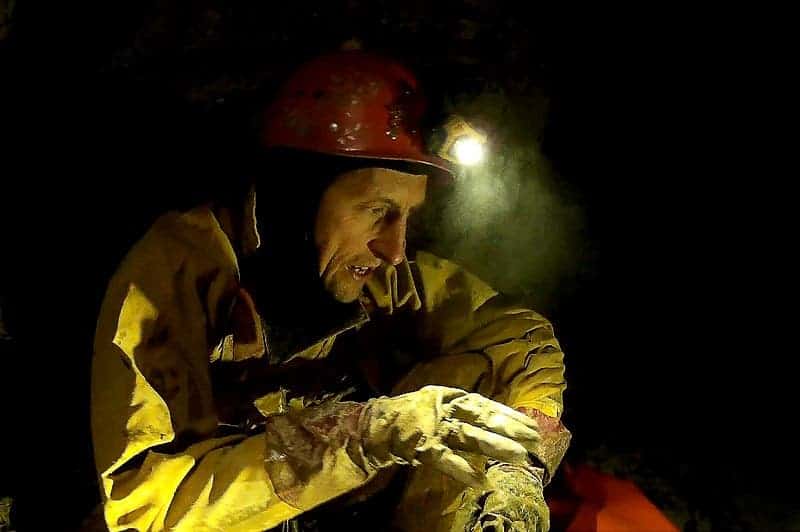
With a record depth of 2,212 meters (7,257 feet), the Verëvkina (Veryovkina) cave is the deepest cave measured thus far in the world. It’s located in the Arabika Massif in Abkhazia, a breakaway region of Georgia that is supported by Russia. Despite its complicated geopolitics, the region is home to not one but four of the deepest caves on Earth.
A decades-long history of exploration to reach the world’s deepest cave
Verëvkina was first discovered in 1968 by Soviet speleologists who only explored a section 115 meters deep (377 feet) and couldn’t comprehend the true scale of this gigantic cave system. In 1983, an expedition led by Oleg Parfenov climbed down a well that led the researchers to a new branch of the cave where they recorded a depth of 440 meters (1,443 feet). It was only much later, in the early 2000s, that new expeditions at Veryovkina were organized by the Moscow-based Perovo Speleo and Speleoclub Perovo caving organizations.
The work proved highly difficult and treacherous. The deeper the researchers went, the more it took for them to bring excavated material to the surface and the greater the mortal peril of collapse. After a few minor expeditions, the researchers finally broke through and reached new sections with a depth of over 1,000 meters (3,200 feet). This victory inspired Russian speleologists to keep exploring, launching expeditions every two to three months until they finally hit gold in 2017 and achieved the world's greatest depth for a cave system.
Using a series of camps along the way, it took expedition members more than four days to reach the terminal sump at a depth of 2,212 meters (7,257 feet). It takes roughly the same time to return to the surface, so the crew had to spend at least a week inside, which is a very long time for such an extreme environment. Due to the endless night, the cavers easily break their biorhythms, working at night and sleeping during the day. Thankfully, communication links with a surface base allow the cavers to contact the outside world and share updates about their progress.

They had to descend thousands of feet on ropes and crawl through water- and mud-choked siphons. The cave goes down almost vertically and is full of wells with small horizontal passages. Starting from the depth of 800 meters (2,600 feet), water flowing through small tributaries splash water through the narrow passageways. This makes the cave extremely damp. The humidity is actually 100% and with a 4 °C to 7 °C temperature range, this means anyone descending will be freezing along the way.
Along the way, they collected samples of rare shrimp and scorpions, and possibly new species of microorganisms. There are also fossils, mainly imprinted on rocks, offering hints about how the cave's organisms might have looked millions of years ago, as well as how the cave itself and the surrounding mountains formed.
The caving heroes

Pavel Demidov, the head of the record-holding expedition, was one of the first to reach it. He described Veryovkina "as if you have had a look at the far side of the Moon," referring to the alien environment of the cave. Right at the very bottom of the cave, there is a vast labyrinth
Demidov passed away on August 23, 2020, in Abkhazia while descending into an unexplored cave in the Arabika Mountain Range, not too far from Veryovkina. The 49-year-old man was killed by a large rock burst at a depth of 305 meters (1,000 feet).
Demidov's tragic death is illustrative of the kinds of dangers cavers face during their treks. In 2018, Demidov's team, which included Petr Lyubimov, Konstantin Zverev, Andrey Shuvalov, Evgeniy Rybka, and Andrey Zyznikov, as well as National Geographic photographers Robbie Shone and Jeff Wade, barely made it out alive after the cave was flooded. Heavy rains can cause water to collect, then, because of the volume, suddenly burst through cave openings.
Despite the extreme conditions, researchers continue to explore Veryovkina and other similar caves in Arabika Massive for various paleontology, biology, and microbiology projects. Some cave organisms may be beneficial to the development of antibiotics.
Four of the world's deepest caves are found in the astonishing Arabika Massive. Besides Veryovkina, these include Krubera-Voronja (2,199 m), Sarma (1,830 m), and Snezhnaja (1,760 m). This is no coincidence. All these caves are carved in karst terrain, which is a rugged landscape with a high elevation and very rich in soluble thick limestone.
| # | Name | Depth (m) | Length (km) | Country |
|---|---|---|---|---|
| 1 | Veryovkina Cave | 2212 | 13.5 km (8.4 mi) | Abkhazia / Georgia |
| 2 | Krubera-Voronja Cave | 2199 | 23.0 km (14.3 mi) | Abkhazia / Georgia |
| 3 | Sarma cave | 1830 | 19.2 km (11.9 mi) | Abkhazia / Georgia |
| 4 | Snezhnaja cave | 1760 | 40.8 km (25.4 mi) | Abkhazia / Georgia |
| 5 | Lamprechtsofen | 1735 | 61 km (38 mi) | Austria |
| 6 | Gouffre Mirolda | 1733 | 13 km (8.1 mi) | France |
| 7 | Gouffre Jean-Bernard | 1625 | 26.6 km (16.5 mi) | France |
| 8 | Sistema del Cerro del Cuevón | 1589 | 7 km (4.3 mi) | Spain |
| 9 | Wot-U-Got Pot | 1560 | 113 km (70 mi) | Austria |
| 10 | Sistema Huautla | 1560 | 89 km (55 mi) | Mexico |
| 11 | Chevé Cave | 1536 | 77.0 km (47.8 mi) | Mexico |
| 12 | Pantjuhinskaja Cave | 1508 | 7.9 km (4.9 mi) | Abkhazia / Georgia |
| 13 | Sima de la Cornisa | 1507 | 6.4 km (4.0 mi) | Spain |
| 14 | Čehi 2 | 1505 | 5.5 km (3.4 mi) | Slovenia |
| 15 | Sistema del Trave | 1441 | 9.1 km (5.7 mi) | Spain |
| 16 | Velebit caves | 1431 | 3.7 km (2.3 mi) | Croatia |
| 17 | Egma Sinkhole | 1429 | 3.1 km (10,000 ft) | Turkey |
| 18 | Boybuloq | 1415 | 14.8 km (9.2 mi) | Uzbekistan |
| 19 | Gouffre de La Pierre Saint-Martin | 1410 | 83.6 km (51.9 mi) | France, Spain |
| 20 | Kuzgun Cave | 1400 | 3.1 km (1.9 mi) | Turkey |
Thousands of other subterranean hidden marvels await discovery
Karst covers up to 25% of the Earth's land surface, and where there is karst, caves are bound to be close by. In fact, scientists believe there may be tens of thousands of undiscovered caves across the world. And some of them probably reach deeper than Veryovkina. The only limit is how far down groundwater can seep into limestone before the pressure becomes too great, and we know from the Soviet-era Kola Superdeep Borehole that this limit is far from being reached by a known cave.
The Kola Superdeep Borehole, the deepest hole in the world, drilled into the Earth from 1970 to 1994 until it reached a staggering depth of 12,262 meters (40,230 ft). Soviet geologists found water still circulating at depths of 6.9 km (4.3 miles), which is more than three times deeper than Veryovkina's cave floor.
One candidate for the title of the world's deepest cave is the Chevé Cave system, a sprawling underground complex in the Oaxaca region of Mexico, where water flow suggests it may descend nearly 2.57 km (1.6 miles) into the Earth. There may be many others waiting to be explored.
However, any super-deep caves are probably inaccessible from the surface and would require some drilling to reach them, provided that scientists can locate them. Remote sensing, such as electrical resistivity, seismic activity, and ground-penetrating radar only work up to a relatively shallow depth or don't have the necessary resolution to identify an underground passageway only a few feet in width.
But developing new methods to reach the world's deepest caves, however challenging, is worth it. Caves are filled with living organisms, particularly invertebrates and microbes, that could help scientists discover new antibiotics and other medicines. They are also time capsules of Earth's past climate, which refine climate models in order to have better projections of future trends.


